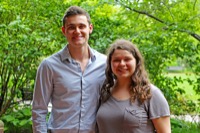Cuba study abroad
UD students experience a pivotal moment in US-Cuba relations
9:08 a.m., April 9, 2015--President Barack Obama announced a change in U.S. foreign policy toward Cuba on Dec. 17, 2014, ending 50 years of conflict and isolation. Less than one month later, 17 University of Delaware students, led by faculty members Persephone Braham and Colette Gaiter, landed in the nearby island nation.
The Winter Session study abroad program, initially focused on the art, culture and history of Cuba, also became a lesson in current affairs and international relations.
Global Stories
Fulbright awards
Peace Corps plans
Students interacted with residents of Cuba, who discussed their feelings toward changing relations with the U.S. and the lifting of the 1960 economic embargo.
“Cubans have huge expectations of this new relationship with the U.S.,” said Braham, associate professor of Spanish in the Department of Foreign Languages and Literatures and former director of Latin American and Iberian Studies. “They have suffered a lot under the embargo that the U.S. imposed in the 1960s. They are really looking forward to things opening up -- for construction, for innovation, for all that has been put on hold for so long.”
The UD students became the first group of American students to visit a Cuban television studio, said Braham, who coordinated the visit through a colleague whose husband is a director of the most popular Cuban comedy Living on Stories, in its English translation.
The studio’s leadership was excited to welcome the UD group, inviting students to visit a second time in order to meet the show’s actors and watch the show being filmed.
Midway through their study abroad program, students also saw and engaged with many international news organizations that arrived in the country as official U.S.-Cuba talks began on Jan. 21.
“Studying Cuba offers an opportunity to look at one of the last socialist/communist countries on earth,” said program co-director Gaiter, associate professor of art. “I thought the students would see capitalism more clearly by experiencing the absence of it. They could also see how the arts are practiced differently.”
The program included academic coursework, resources and site visits. Braham taught “Sugar, Salsa and Santería: Contemporary Cuba and the Caribbean.”
She described the course, noting that “sugar stands for Cuba’s past of sugar and slavery, salsa stands for traditional Cuban music, and Santería is the notion of a syncretic religion … a mixture of both European and African influences that reflects the mixture that is evident in Cuban society.”
Gaiter taught a course titled “Art and Design in Cuban Life.”
“History and culture are also inextricably woven into the arts,” she said. “Afro-Cuban culture, as well as Spanish culture, is evident in visual representations of Santería and Abakuá icons, gods and figures. Cubans keep their history and culture alive through the arts.”
Students read fundamental texts about the slave trade in Cuba and the revolution, and viewed art in local museums and throughout the city of Havana. “The students were surrounded with beauty, natural and created. All this was juxtaposed against extreme poverty and near-ruin,” said Gaiter. “We definitely experienced the aesthetics of extremes.”
Students documented their time in Cuba through visual journals where they wrote about their experiences, as well as mounted art they were given or found. Gaiter hopes to display students’ artwork as well as their photographs during an exhibition to be announced later this semester.
Students returned to campus with gained understanding of the many facets of Cuban life, as well as with greater insight into their own lives.
“It changed many students’ views of their place in the world, and of what we have living in the United States compared to people in other parts of the world. It changed their views about the role of money in a happy life -- the vast majority of Cubans are incredibly poor, but in fact have very rich cultural lives,” said Braham.
About study abroad
The University of Delaware is a national leader in study abroad programs. Approximately 35 percent of undergraduates study outside of the U.S. on an annual basis. Winter Session is the most popular time for Delaware students to do so, with about 80 percent of all study abroad activity taking place during this semester.
The year 2013 marked the 90th anniversary of the University’s study abroad program, considered the first in America when eight students set sail for France in 1923.
Since then, UD has continued to expand education abroad opportunities to include academic coursework, internships, research, and service learning across the globe.
Those with interest can explore UD study abroad programs online, follow #UDAbroad and @UDGlobal on social media, and attend an interest meeting to learn more.
Article by Jessica Franzetti













